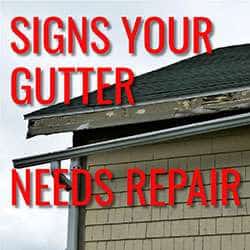A properly functioning gutter drainage system is essential for any building as it redirects water away from the building. That helps prevent water from seeping underneath and weakening the building’s foundation. Therefore, it is critical to identify any faults in your gutter as soon as possible.

A properly functioning gutter drainage system is essential for any building as it redirects water away from the building. That helps prevent water from seeping underneath and weakening the building’s foundation. Therefore, it is critical to identify any faults in your gutter as soon as possible.
Signs Your Gutter Requires Repair
- Gaps, Cracks, or FracturesA visible gap, crack, or fracture allows water to leak out and enter your home or fascia. These flaws will keep any extra water accumulation from being directed away from your home’s exterior. Also, remember that small cracks gradually turn into large fractures, resulting in even bigger problems down the line.
- Standing WaterStanding water indicates a likely blockage in your home’s gutter or in its downspout. If you are unable to identify a blockage in either one of these fixtures, it is time you get a new gutter installed.
- Sagging GuttersA bowing gutter or one pulling away from your house means the brackets on your gutters may be loose. Timely repair of the drainage system at this point can prevent possible property damage in the future, in addition to gutter breakage.
- Peeling PaintHouse paint peels primarily due to the presence of constant moisture. Modern paints are generally designed to withstand heavy damage incurred by the elements. Still, if you witness paint flaking off, you must conduct an inspection to determine if your gutter is the cause of the problem.
- RustingExcessive rainfall may result in gutters succumbing to rust. While rusting does not impede regular functioning, it results in wear over time. For this reason, it is best to install new gutters before the rusted one shatters and breaks.
- Water Damage MarksWater damage marks display themselves in the form of discolorations on the outside, fascia, or downspouts of your home. They indicate moisture-induced damage and must be attended to before it spreads out. Suppose you observe any discolorations in your home. In that case, you must get your gutters checked out by a professional and replace them immediately to avoid further damage.
- Mold GrowthMold is a common finding on the outside and in the basements of most homes. If your gutter is working correctly, you do not have to worry about this factor. But, if there is a fault in your drainage system, there is a chance that it may be carrying more moisture to the existing mold. Remember that not only is mold incredibly damaging to the infrastructure of your home, but it is also a breeding ground for allergens. Make sure to get your gutters repaired if you come across mold in your home.
- Soil ErosionIf the soil in your garden gets thinner, it might be due to excess precipitation. Faulty gutters allow water to run loose in your yard and carry dirt along with it. Soil erosion is not just bad for your garden, but it also exposes your home’s foundation to potential water damage. This one may be hard to identify, but when you do, make sure to arrange for a gutter inspection.
- Foundation ProblemsFoundation problems like shifting and cracking are often the result of moisture seeping into the soil underneath your home. A bad gutter can leak water, leading to standing puddles. These standing puddles get absorbed into the house’s foundation over time, causing it to shift or even break.
- Unexplained Nails or ScrewsIf you notice any nails or screws in your garden near your home’s roofing, there is a chance that your gutter may be working itself loose. To ensure the safety of your home’s drainage system, get that gutter section repaired or replaced.

